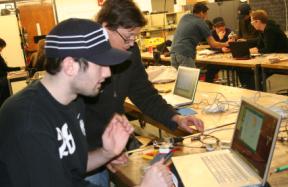UARTS 250 (Creative Process): One of the universitys most intriguing classes
The new course brings together faculty from Art, Architecture, Engineering, and Music — all found on North Campus.

 Enlarge
Enlarge
“We are actually having fun! This is the University of Michigan. We’re here to learn and we’re here to do serious things. But play, I think, is the foundation for most creativity.” This is how Prof. Herb Winful, professor of Optics in the Department of Electrical Engineering and Computer Science, talks about the course “UARTS2 250: Creative Process,” a new course that brings together faculty from Art, Architecture, Engineering, and Music – all found on North Campus at the University of Michigan.
A creative thought can come in a flash. Though it often requires a long process to perfect, the creative process can be seen at every stage. “Developing an idea can be as creative and adventurous as coming up with the idea in the first place,” says Winful.
A recent video made by the Michigan Daily will give a glimpse of the faculty who teach the course, and the students who take it. Prof. Winful, Arthur F. Thurnau Professor, and John Nees, research scientist in ultrafast optics, were part of the team of faculty that taught the course Winter term 2009.
“This is one of the most fun courses I’ve ever taught,” said Prof. Winful.
Students were first shown the popular Youtube video, “Canon Rock,” played by Funtwo (real name Jae-Hyun Lim, a computer science major) and discussed how engineers were involved at most every stage of creating the video, and the perfect electric guitar.
This goes back even to Michael Faraday (1791-1867), who invented the transformer and electrical generator as well as the principle of electromagnetic induction which underlies the operation of the electric guitar pick-up.

 Enlarge
Enlarge
Winful and Nees showed students how to make the world’s simplest motor, before helping student teams develop engineering and artistic creations using the PicoCricket invention kit (complete with standard electrical and computer engineering devices such as sensors, a motor board, and a “beamer” to send programs from your computer to the PicoCricket).
Prof. Winful shares these tips for the creative engineer:
- Keep an idea notebook (ie, da Vinci)
- Expose yourself to ideas
- Be observant
- Think!
- Reflect
- Look for symmetries
- Look for analogies
- Change your perspective
- Ask questions
- Seek beauty and simplicity (ie, Einstein)
- Be persistent
- Embrace failure (“I have not failed. I’ve just found 10,000 ways that won’t work,” Thomas Edison)
- Dream
- Play
- Make lemonade from lemons (ie, invention of post-it notes)
- Expect serendipity
- Take risks
- Publish!
- Seek improvements
The course has gone international, and is now part of the College of Engineering’s Study Abroad program as students head off to France for the Spring 2009 course.
UARTS 250: Flyer, Creative Process in France
 MENU
MENU